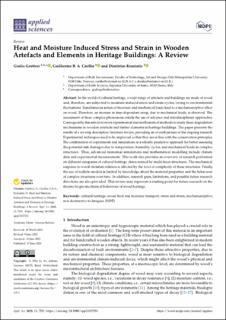| dc.description.abstract | In the world of cultural heritage, a wide range of artefacts and buildings are made of wood and, therefore, are subjected to moisture-induced stress and strain cycles, owing to environmental fluctuations. Simultaneous action of moisture and mechanical loads lead to a mechanosorptive effect on wood. Therefore, an increase in time-dependent creep, due to mechanical loads, is observed. The assessment of these complex phenomena entails the use of advance and interdisciplinary approaches. Consequently, this article reviews experimental and mathematical methods to study these degradation mechanisms in wooden artefacts and timber elements in heritage buildings. The paper presents the results of a six-step descriptive literature review, providing an overall picture of the ongoing research. Experimental techniques need to be improved so that they are in line with the conservation principles. The combination of experiments and simulations is a reliable predictive approach for better assessing the potential risk damages due to temperature, humidity cycles, and mechanical loads in complex structures. Thus, advanced numerical simulations and mathematical modelling include climate data and experimental measurements. This work also provides an overview of research performed on different categories of cultural heritage characterised by multi-layer structures. The mechanical response to wood–moisture relation is affected by the level of complexity of these structures. Finally, the use of realistic models is limited by knowledge about the material properties and the behaviour of complex structures over time. In addition, research gaps, limitations, and possible future research directions are also provided. This review may represent a starting point for future research on the thermo-hygro-mechanical behaviour of wood heritage. | en_US |

